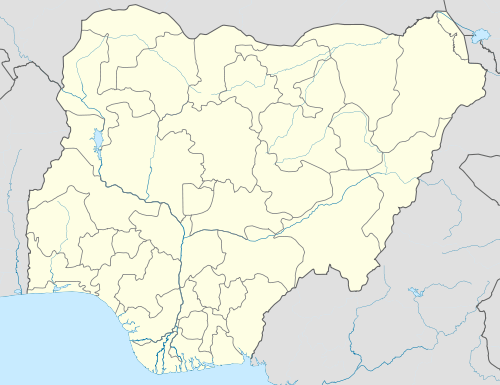Katsina-Ala
| Katsina-Ala | |
|---|---|
| LGA and town | |
 Katsina-Ala | |
| Coordinates: NG 7°10′0″N 9°17′0″E / 7.16667°N 9.28333°ECoordinates: NG 7°10′0″N 9°17′0″E / 7.16667°N 9.28333°E | |
| Country |
|
| State | Benue State |
| Local Government Headquarter | Katsina-Ala |
| Time zone | WAT (UTC+1) |
Katsina-Ala is a Local Government Area (LGA) of Benue State, Nigeria. Its headquarters are in the town of Katsina-Ala where the A344 highway starts. It is also the location of an important archeological site where artifacts of the Nok culture have been found.
Community
The LGA of Katsina-Ala has an area of 2,402 km² and a population of 224,718 at the 2006 census. The town center is the location of one of the oldest schools in Nigeria, Government College Katsina-Ala, founded in 1914, and has produced many prominent members in Nigerian society. The postal code of the area is 980.[1] The community, which lies on the banks of the Katsina Ala River, a major tributary of the Benue River, is mainly occupied by Tiv.[2]
Archeological site
Terracotta statues were found at Katsina Ala in the middle of the twentieth century. They include realistic representations of human heads, with some animals, and parts of larger statues. The statues are similar to others found at Nok, about 209 km to the north, and are thought to have been made by people of the same culture.[3] The human figures most likely represented ancestors or spirits. According to Bernard Fagg, an archeologist who undertook extensive studies into the Nok culture, the works at Katsina Ala constitutes a distinctive sub-style.[4] Statues from Taruga and from Samun Dukiya are similar, but have typical stylistic differences.[5]
Iron working began at the site in the fourth century BC, somewhat later than iron working at Taruga.[6] Smelted tin beads have also been found on the site, some of which could be imitations of cowrie shells.[7]
References
- ↑ "Post Offices- with map of LGA". NIPOST. Archived from the original on 2012-11-26. Retrieved 2009-10-20.
- ↑ Thurstan Shaw (1995). The Archaeology of Africa: Food, Metals and Towns. Routledge. p. 275. ISBN 0-415-11585-X.
- ↑ James R. Penn (2001). Rivers of the world: a social, geographical, and environmental sourcebook. ABC-CLIO. p. 26. ISBN 1-57607-042-5.
- ↑ Hope B. Werness (2003). The Continuum Encyclopedia of Native Art: Worldview, Symbolism, and Culture in Africa, Oceania, and North America. Continuum International Publishing Group. p. 223. ISBN 0-8264-1465-6.
- ↑ G. Mokhtar (1981). Ancient civilizations of Africa. University of California Press. p. 611. ISBN 0-435-94805-9.
- ↑ Elizabeth Allo Isichei (1997). A history of African societies to 1870. Cambridge University Press. p. 70. ISBN 0-521-45599-5.
- ↑ Kit W. Wesler (1998). Historical archaeology in Nigeria. Africa World Press. ISBN 0-86543-610-X.
